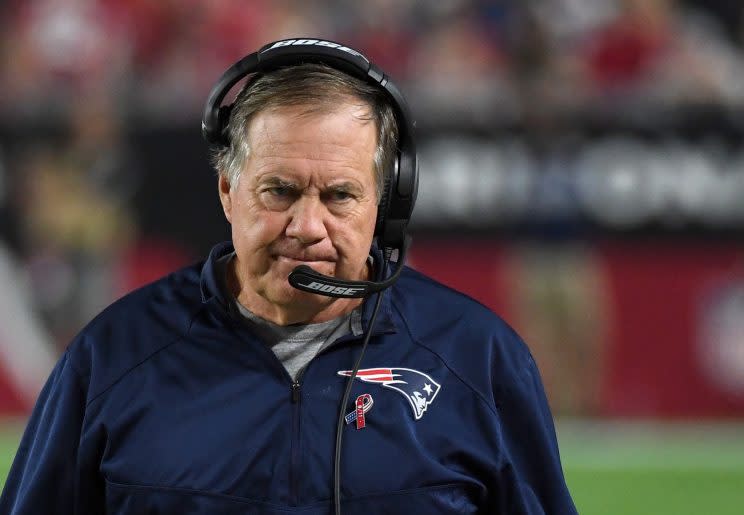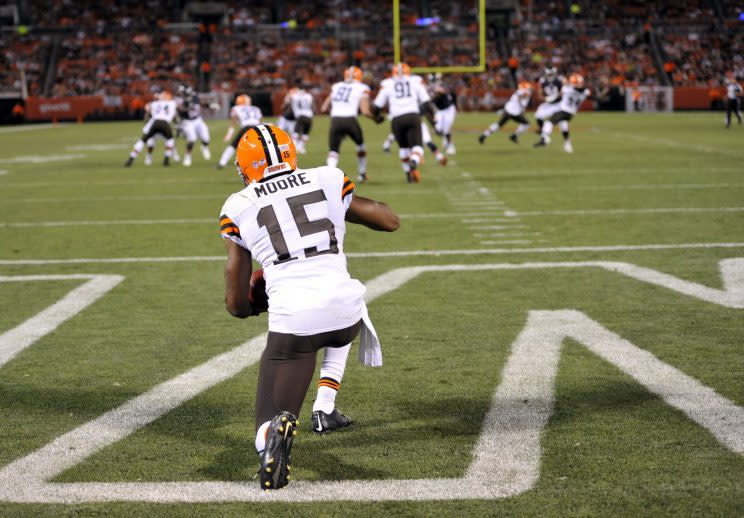Bill Belichick isn't bending to NFL kickoff rule and others may follow suit
GLENDALE, Ariz. – Courtesy of a field goal, the New England Patriots had just taken a 23-21 lead against the Arizona Cardinals with less than four minutes remaining in Sunday’s game.
The ensuing kickoff was next. It’s a play the NFL is trying to, if not eliminate, at least minimize due to safety concerns. Having 11 players charge down a field and collide with 11 others – blockers or ball carrier – makes the kickoff one of football’s most dangerous plays. This decade the league has implemented rules to make touchbacks more common, mostly by moving the kickoff spot up to make it easier to boot the ball in, or through, the end zone. As such, violent contact becomes more rare.
It has mostly worked. In 2010, 80.1 percent of kickoffs were returned. Last year that was nearly halved to 41.1 percent. In an effort to further discourage receiving teams from attempting returns, the NFL went with a new rule this year: downed kicks in the end zone would bring the ball out to the 25-yard line rather than the 20.
We’re only one week into the season, a painful small sample size, but it may be backfiring.

New England coach Bill Belichick, among others, appears to have considered the rule differently than intended. The 25-yard line change may indeed incentivize a receiver to take a safe knee, but it also tempts the kicking team to hit it higher and shorter and force a return. Giving up those 5 extra yards is too valuable.
Here, late in the action in Arizona, was the real-time, game-on-the-line example. Patriots kicker Stephen Gostkowski didn’t blast the kick into the end zone hoping for a touchback. Instead, he booted it as high as possible, giving his teammates time to rush down the field, hoping to land close to the 1-yard line and forcing a return.
[ STACK: The NFL’s secret freak athlete: Josh McCown ]
It worked. The Cardinals’ Andre Ellington took it at the 3 and rushed forward, only to be tackled by Nate Ebner and Patrick Chung at the 17. That alone meant plus-8 yards for New England. There was more however. The Patriots’ Jonathan Jones had come flying down the field only to draw a holding penalty on the Cardinals’ Tyvon Branch. That sent Arizona all the way back to their own 8-yard line – now a plus 17-yard play for New England.
In a moment when Arizona needed every inch to get close enough for a game-winning field goal – it would miss a 47-yarder – those 17 yards may have been the reason the Patriots eventually won the game.
“In the end,” Belichick said, “those yards showed up at the other end of the field.”
So here is what to look for going forward: did the NFL go one move too far in an otherwise admirable attempt to curb what is often the mundane, but injury rich, kickoff return while still maintaining the possibility of an exciting touchdown or essential onside kick?

In Week 1 of this year, 37.6 percent of kickoffs were returned. That is up from 30.1 percent for Week 1 last year, according to Newsday. It is also before influence leaders such as Belichick can affect future attempts by other coaches across the league. Note: that is still below the 2015 full season return-rate and just 23.1 percent of kicks hit into the end zone were returned, so it’s not all a failure.
Dean Blandino, the NFL vice president of officiating, said in August that the league will evaluate the rule after the fourth week of the regular season – believing that may be enough of a sample size. Kick returns were up during the preseason, but coaches often want to get work in for their special teams and aren’t as focused on game strategy, so no one was certain what to make of the trend.
In the opening weekend, many teams still blasted away – Detroit and Indianapolis, for example, combined to send all 14 kickoffs into the end zone (11 were downed). Others were more strategic. The Oakland-New Orleans game saw just six of 14 combined kickoffs soar past the goal line. New England, meanwhile, placed two of its six kicks inside the 5. That was the plan.
“We went into the game feeling like we had to make some field position plays in the kicking game,” Belichick said. “Obviously you don’t want to put their offense on a short field. If you can pile a few more yards onto the drive, hopefully it works in your favor.
“I know there is a lot of sentiment to eliminate that play but I think those are the kinds of plays that are good strategy plays in football,” he continued. “Certainly we had an opportunity to kick it out of the end zone on the last kickoff. [They have a] good field goal kicker, good quarterback, good offense, [so] we tried to put them on as long of a field as we could.”
Part of it was the hope that his players could make a tackle before the 25. Another part, he noted, was that holding or blocking below the waist penalties are common in the chaos of a kick return. That’s especially true if a team has a gunner such as Jones applying pressure on blockers. In this case both things happened. He may not have risked it though if a touchback was at just the 20.
“Great situational play we needed to make at that time,” Belichick said. “Obviously, the big play in the game was the kickoff. That field position ended up being a real big fact there, I’m sure, on the final kick.”
This was but one kickoff in one week of a long season. However, it also featured the game’s most creative and respected coach coaxing a victory by eschewing the planned effect of one of the NFL’s new rule tweaks.
Time will tell if the trend continues, but when Belichick embraces a strategy, the league tends to follow. The new plan might be high and short, not long and deep. If so, the NFL might be quickly back to the drawing board.
More NFL on Yahoo Sports

